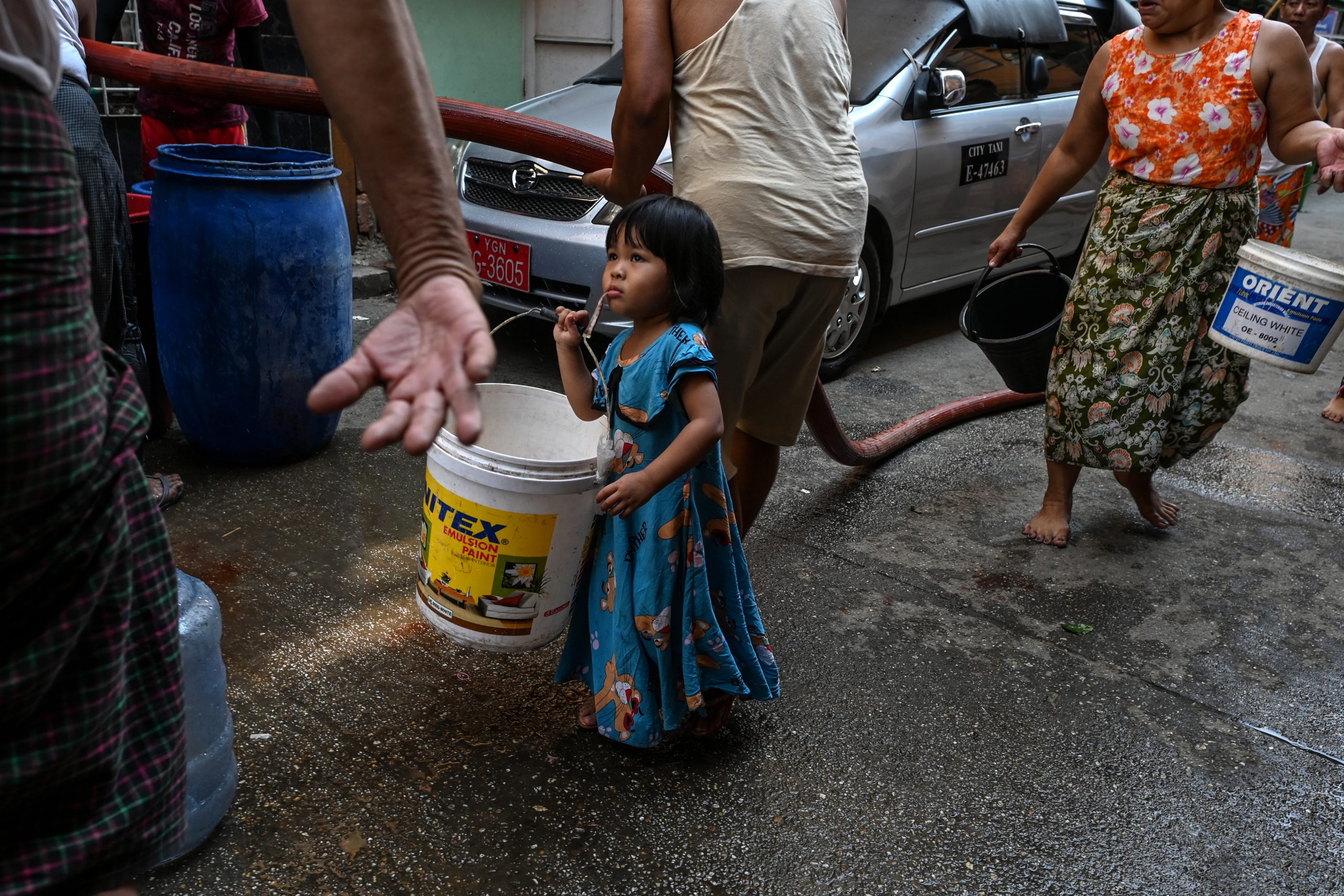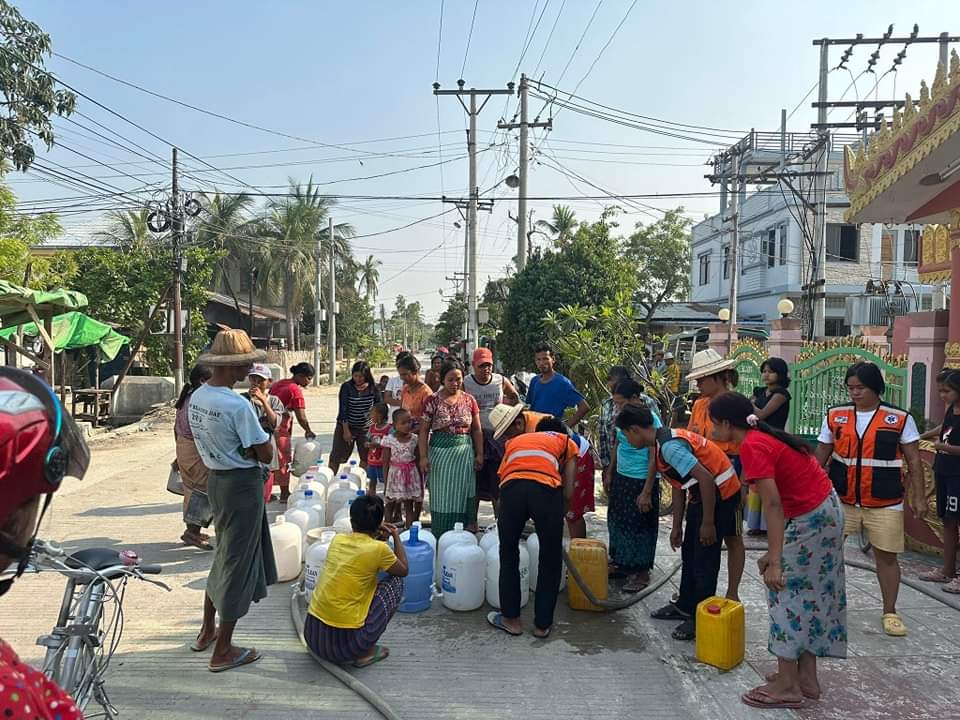Daw Tin Yi jolts awake at midnight as the lamp over her head flickers into life. The electricity just came back on!
The 65-year-old immediately rises from her bed and turns on the water pump.
Although the sound of the machine will disturb her neighbors, the Yangon resident knows she must act now, while there is electricity.
Next, she switches on her electric pan to cook the curry and rice.
Although it is 1.30 am, Daw Tin Yi goes about her domestic chores as if it were daytime.
“If I stayed asleep, my family would be short of water tomorrow because there will be a power outage the whole day,” Daw Tin Yi told The Irrawaddy.
Prolonged power outages have blighted life for people in Myanmar, especially in big cities like Yangon, since the military coup in 2021. The situation has got worse since last year, with electricity supply reduced to three hours or four hours per day, adding to other daily hardships.
Once reserved for sleep only, nighttime is now a period for housework as city-dwellers get busy pumping water, washing clothes, and cooking during the precious few hours when the power is on.
Ma Zar Chi, a mother of two children, is one among many who jump into action after dark. The woman in her forties says she stays awake the whole night in a desperate effort to pump enough water to store in her Yangon city home.
She tries to pump water every other night, but the disrupted electricity supply often reduces the flow to a trickle – or worse.
“I lost sleep yesterday but I couldn’t get even a little water. It was so frustrating,” Ma Zar Chi told The Irrawaddy.
Reasons for power outages
Blackouts have expanded across the country since early 2022, affecting even the commercial hubs of Yangon and Mandalay. Myanmar has the lowest electrification rate in Southeast Asia with only 50 percent of households connected to the public grid, according to the World Bank.
According to a report by the NLD government in January 2021, 40 percent of Myanmar’s electricity is generated by hydropower, 14 percent by solar power plants, 34 percent from domestic natural gas, and 11 percent from LNG (natural gas).
Up until 2021, the country generated about 3,700 MW daily and Yangon consumed about half of that amount. However, daily power generation declined from 3,711 MW in October 2021 to 2,665 MW in March 2022.
Since the coup, LNG power plants producing about 750 MW have been suspended, with rising gas prices cited as the reason. The power plants were supplied by an LNG ship owned by Hong Kong-based CNTIC V Power, which left Myanmar permanently in March.
The state-owned Yangon Electrical Supply Corporation (YESC) said in April that production capacity of large hydropower plants in the national power system has fallen in line with dry, summer conditions, resulting in widespread electricity shortages across the country.

Junta boss Min Aung Hlaing claimed in January he was working on a plan to secure enough electricity by 2025.
The Myanmar government and the World Bank began implementing the National Electrification Project (Off-Grid) in 2015, aiming to hook up all Myanmar households by 2030. However, energy projects approved as part of the plan before the military takeover have been suspended following the coup.
A former National League for Democracy (NLD) MP said the NLD government prioritized development of the energy sector since it is a key sector for economic development.
“Our government spent a lot of budget on electricity,” the former MP told The Irrawaddy.
Extra expenses hit households, livelihoods
Yangon residents recall summer blackouts under the NLD government but said they don’t compare with the current prolonged and frequent power outages.
Yangon local Ma Khin Khin Tun has been forced to use a back-up plan after prolonged power cuts threatened her livelihood. She bought a battery and inverter last year to use for her job.
“It is terrible to have extra expenses in a situation where income has not increased while commodity prices are skyrocketing,” she told The Irrawaddy.
Housewives like Daw Tin Yi and Ma Zar Chi are also spending more money to buy gas and charcoal for cooking.
The price of these fuels has increased two to three times compared with the pre-coup period as demand surges amid the rolling blackouts.
“We need to fill up on gas for cooking and buy rechargeable LED battery bulbs for light at night. We are spending extra money because they don’t provide electricity regularly,” Daw Tin Yi told The Irrawaddy.
The people of Myanmar are also facing other economic and social hardships as a result of the electricity shortage.
Water shortages
Residents of Mandalay, Myanmar’s second-largest city, have faced water shortages since April as prolonged power outages put their water pumps out of action.
A Mandalay local explained that electricity is supplied for around three hours per day – half of what the Mandalay Electrical Supply Corporation (MESC) has promised.
“People are struggling because they lack power and water amid the seriously hot weather,” one resident of Mandalay told The Irrawaddy.
Locals from six townships in Mandalay are having to rely on water donated by social welfare organizations. The organizations are distributing water across Mandalay, except in Amarapura Township where residents have private wells.

One organization member said it has been distributing around 20,000 gallons of water per day on three trucks since April 20.
He said Mandalay was still suffering water shortages in the first week of May.
“There has never been a citywide water outage for this length of time,” he told the Irrawaddy.
SMEs on brink of collapse
The lack of electricity has left small and medium enterprises (SMEs) at risk of collapse under junta boss Min Aung Hlaing, who likes to emphasize the importance of SME development.
SME entrepreneurs are spending extra for fuel and transport, undermining the long-term viability of their business, according to Ma Theint, a food-product entrepreneur in Yangon.
She said many processes which need electricity are being powered by generators, which cost more money. A friend of hers who produced ice cream shut down the business in the past month.
“I’m also thinking of closing my business,” Ma Theint told the Irrawaddy.
She said there had been no progress or development in the country under military rule.
“I just want to tell him [Min Aung Hlaing] that he should not be ruling the country without any ability,” she added.
Prominent anti-regime protest leader Dr. Tay Zar San said the country’s socio-economic situation was thrown into turmoil by the 2021 coup as the regime lacks any capacity to bring stability or development.
“If military rule is entrenched, the situation will only get worse,” he said.
Meanwhile, in the absence of electricity, people are longing for the rainy season to bring relief from sweltering summer temperatures.
Rolling blackouts mean the public is being exposed to daily temperatures of up to 40C without the protection of air-conditioners or electric fans, especially at night. The meteorological department forecasts this will be Myanmar’s hottest year on record.
People enduring night after night of sleeplessness in Yangon and elsewhere can only pray for early rain.
Exasperation has now reached boiling point on Myanmar social media.
“I wouldn’t mind even a cyclone hitting Yangon if it would make us cooler!” declared one online post recently.

















